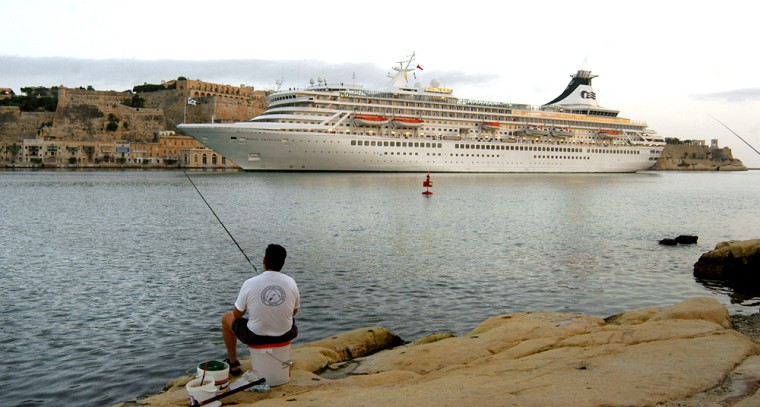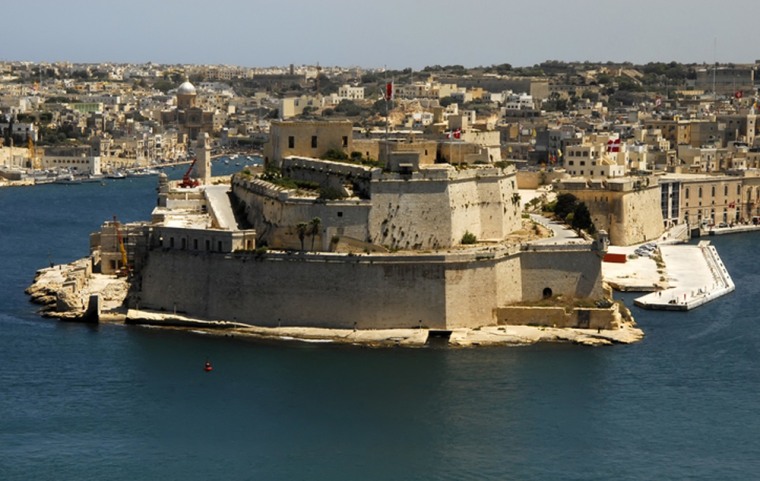The best for food
Favignana, Italy
Given the fact that it lies less than 25 miles from Sicily, an island with phenomenal cuisine, you’d expect petite Favignana to plate up some smashing food. And it does.
Historically, Favignana has supplied Sicily with fresh seafood, notably tuna, because this, the southernmost of three Egadi Islands, is an island of both fishermen and chefs. Enter a trattoria on Favignana and prepare to walk out a glutton, albeit a jolly one. Fish, shellfish, octopus and cuttlefish are stewed, grilled and stuffed, accompanied by tomatoes, capers and olives.
Vibrant flavors contrast with a dry, barren island landscape where not much more than a smattering of wild flowers, caper bushes and fennel can be found. The islanders have always turned outward to the sea for a living. The daily catch and its preparation became so important to their way of life that it was almost religious in nature — as if anointing the fish in delicate sauces and pairing it with delectable herbs was a way for islanders to pay their final respects to the marine creatures who sustained them. In fact, cave paintings found in Levanzo, another of the Egadi Islands, prove that tuna has been important to this culture for more than 5,000 years.
Every May and June bring a full-blown bluefin tuna heyday when schools of tuna are corralled in a system of nets called tonnara during the mattanza ritual. This is one of the last places you can witness this ritual, and it’s surely a sight to see — the tuna can weigh in at up to 1,800 pounds and grow to 14 feet long. Teams of swarthy fishermen haul netful after netful of tuna out of the water, praying and singing songs to a strict Arabic cadence.
Worldwide overfishing has greatly affected the mattanza, and catches today are not like they were before islanders were forced to compete with commercial boats. But the aroma of traditional, breaded and fried tuna steaks still takes over Favignana in such a way that it can seem like this is the best food anywhere. Uk.favignana.com
The best for history
Malta
A prime location, between Sicily to the north and Tunisia to the south, thrust the small island of Malta into notoriety. Without this splendid positioning, Malta would have been an unremarkable island with little fresh water, a rocky landscape and poor soil; not the bastion of history it was to become. The island has many museums, from archaeology to natural history and from maritime to war. It is one of the few places in the world where you can just call out a time period — Norman, Gothic, Renaissance or Baroque — and find easy evidence of it etched in the facades around you.
Nearly all of Malta’s sites are open for visitors (though some restrict the size of crowds), so wandering around is by far the best way to experience what could only be called living history. The Mnajdra ruins are made up of three ringed temples dating to 3,000 B.C. and are an excellent example of the period’s craftsmanship. Malta’s capital, — Valletta, was raised by the Knights of St. John in the 16th century, and many of the Knights’ stately sandstone buildings still stand. The Grand Master’s Palace is still a central part of society here, now housing the Maltese Parliament and President Guido de Marco’s offices.

As if Malta needed more bragging rights to be “Best for History,” a stonemason laying a foundation in 1902 stumbled upon an archaeological goldmine: the Hal Saflieni Hypogeum, an ancient underground sanctuary, shrine and burial chamber. The entrance to the hypogeum, which is older than the pyramids, was found just outside Valletta, in the suburb of Paola. It contains more than 30 different chambers and an estimated 7,000 human remains, and it was constructed in three different phases, beginning almost 6,000 years ago. Holes cut in the walls of the chambers suggest that priests and oracles would broadcast their preachings throughout the structure. The further excavation in subsequent years has found an abundance of archaeological finds, from human bones to ornaments and amulets, and from carved animals to special pottery.
To preserve the site, only 80 visitors are allowed into the Hal Saflieni Hypogeum each day. Seven daily tours are led through the site, beginning at 9 a.m. Visitmalta.com
The best for beaches
Jerba Island, Tunisia
The exotic countries of Northern Africa are not often associated with the Mediterranean, but right off — Tunisia lies a hidden Mediterranean gem. Jerba Island is trimmed with some of the region’s finest beaches, offering long stretches of actual sand. That’s unusual in the Med, where beaches often consist of stones the size of marbles (or tennis balls in some places) and sunbathing means forking over dough for a chaise lounge, to avoid the rocks’ invasive pokes and prods.
Beaches add to the overall charm of Jerba, which has maintained a reputation as a powerful place for thousands of years, ever since Ulysses and his men landed here in The Odyssey. This is where the men were fed the magic lotuses, which caused the memories of their homes to dissipate as easily and completely as spectres in the wind.
Jerba is especially memorable that can appear flat as a pancake. The island’s 100 miles of coastline feature rugged, rocky cliffsides on the west coast that give way to pristine, white-sand beachfronts in the east. You might not think Africa when you think Mediterranean, but here you’ll see the sun set over beautiful mosques and lively souks (markets). Even the silhouettes of pink flamingos will become familiar sights. In particular, we recommend Sidi Mahres and Seguia as two must-stops you’ll find along the island’s northeastern coast.
Most of the population of Jerba is Muslim, so sunbathing in risqué attire is primarily practiced only by visiting Europeans on the northeastern coast. They choose prime spots on the sand and relish the island’s popular thalassotherapy treatments, which use the seawater to heal and replenish the body. You can venture inland for cities adorned in the Arabian- and Moorish-style architecture, complete with magical souks, which give the places a strong feeling of mysticism. Jerba is easily accessible by driving across a causeway that connects it to the Tunisian mainland, but this unique island can seem like a world away. Tourismtunisia.com
The best for architecture
Corfu, Greece
Multi-storied buildings with delicate latticework, beautiful arched doorways and an elegant demeanor can be found in great supply — and perfect preservation — on the Greek island of Corfu, just west of mainland Greece. Here the Venetians ruled from the 15th to the late 18th centuries, so it is their architectural style, and not that of the Greeks, that stands out.
The capital of this Ionian island is Corfu Town, on the east coast, a good starting point for those who love to be surrounded by the art of architecture. It’s a typical Venetian town, with a unique highlight: a series of archways in the Liston colonnade. Take a spin around a section of Corfu called Old Town, a mess of tightly packed cobblestone streets with interesting back alleyways. Here modern boutiques, tavernas and lively bars are housed in historic buildings. Two grand fortresses are also nearby: Palaio Frourio, or Old Fortress, was originally Byzantine but was reworked by the Venetians between the 13th and 15th centuries. Neo Frourio, or New Fortress, was constructed entirely by the Venetians before 1589.
Head to the village of Gastouri, where you’ll find the Achilleon, which is a Rococo palace built by an Austrian empress and later used as the backdrop for a James Bond movie.
Corfu has been passed around more than the village bicycle (from the Venetians to the Turks and from the Russians to Napoleon to the British), a fact that is echoed in the architecture. In the end, the Venetians’ artisan touch has withstood the test of time. Greektourism.com
The best for adventure
Corsica, France
Often called the “Mountain in the Sea,” the French island of Corsica is an adventurer’s playground. It boasts the highest mountains and the most rivers of all the Mediterranean, with an amazing 21 mountains that are more than 6,500 feet tall.
If you’re in the mood for some serious adventure, head to the GR20 (Grande Randonnee, or “big excursion” in French). It’s a trail of more than 100 miles that zigzags north to south across the island from Calenzana to Conca. The GR20 is considered the most difficult of the network of GR trails that stretches across much of Europe, including Belgium, the Netherlands and Spain. This is not for the faint of heart. Think a shorter but equally challenging version of the Appalachian Trail. The GR20 is marked in most places by red and white signs, and it can be completed in its total glory in about 15 days. Hike between early June to mid-October to be sure to miss the snow on the highest passes.
The northern part of the trail, from Calenzana to Vizzavone, is the hardest, presenting steep and rocky paths. So for a lighter but still thrilling experience, hop a train to Vizzavone, about the halfway point, and hike south to Conca. Be sure to make a stop at the Coscione Plateau to take in all of its green, meadowy glory.
Another great but less-intense trail is the Tra Mare e Monti, which crosses the GR20 and stretches across the northwest region of the island from coast to coast. Hike down mule paths and across mountain passes that offer far-reaching vistas. One of the greatest aspects of this trail is that it lets you get up-close and personal with some of the small fishing villages that most travelers never see. Spend the day traversing miles of chestnut- and pine-forested river valleys and then retreat to quaint cafes and lovable coffee shops.
If you’re more of a water person, then you can try to take on churning rapids, paddle in hand, during the months of March and April when snowmelt fills the gorges and swells the rivers into rapids. While there are challenges here for even the most experienced paddlers, anyone can go into the Tavignano River, also in the northwest, which rushes between the walls of narrow canyons for a lovely and at times thrilling run.
Both the most daring of thrill-seekers and those visitors who are just looking for a lesser brush with nature will be able to find refuge here on Corsica. Us.franceguide.com
Each issue of explores the most beautiful island destinations in the world, from tropical island outposts to the sophisticated gems of the Mediterranean. Our top-rate photographers and writers discover the quiet beaches, boutique hotels, and unique cultural experiences that make island travel unique.
